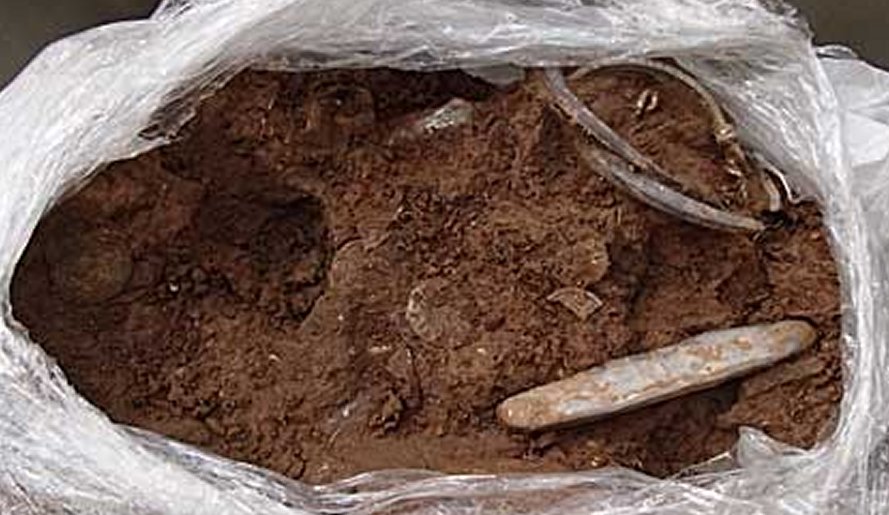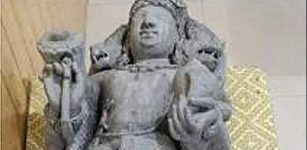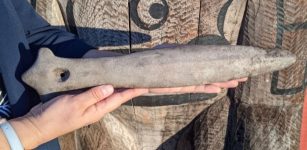Watlington Viking Hoard May Re-Write History Of England
AncientPages.com - British Museum presents a Viking Hoard dating from the time of the ‘Last Kingdom’, when the Anglo-Saxon kingdoms of Mercia and Wessex were fighting for their survival against a ‘Great Heathen Army’ of Viking raiders.
This most valuable hoard was discovered by metal detectorist James Mather in a field in Watlington, Oxfordshire and reported through the Portable Antiquities Scheme (PAS), headed up the launch of the PAS annual treasure report at the museum, which details the thousands of finds reported by detectorists and amateur archaeologists via a network of local museums.

The 186 coins (some fragmentary), seven items of jewellery and 15 ingots were then examined by experts from the museum alongside colleagues from the Ashmolean Museum in Oxford. © PAS
The hoard includes rare coins of King Alfred ‘the Great’ of Wessex (r.871-99) and King Ceolwulf II of Mercia (874-79), as well as Viking arm-rings and silver ingots, and is said by archaeologists to be nationally significant.
Experts believe the hoard was buried around the end of the 870s, in the period following Alfred’s decisive defeat of the Vikings at Edington in 878, a victory which lead to the unification of England.
Following their defeat, the Vikings moved north of the Thames and travelled to East Anglia through the kingdom of Mercia. It seems likely that the hoard was buried in the course of these events, although the precise circumstances will never be known.

Experts believe the hoard was buried around the end of the 870s, in the period following Alfred’s decisive defeat of the Vikings at Edington in 878, a victory which lead to the unification of England. © PAS
The 186 coins (some fragmentary), seven items of jewellery and 15 ingots were then examined by experts from the museum alongside colleagues from the Ashmolean Museum in Oxford.
Recalling the experience of finding the hoard and helping excavate it with archaeologists from the PAS, finder James Mather said it was the “icing on the cake of my 60th birthday”.
“It highlights how responsible metal detecting, supportive landowners and the PAS contribute to national archaeological heritage.” “I hope these amazing artefacts can be displayed by a local museum to be enjoyed by generations to come," Mather said.

In 867 Æthelred's brother-in-law, Burghred king of Mercia, appealed to him for help against the Vikings. Æthelred and his brother, the future Ælfred the Great, led a West Saxon army to Nottingham, along with Edmund, King of East Anglia, but there was no decisive battle, and eventually Burghred bought off the Danes and they retreated to York...Artist Mark Taylor: Go to his website www.wyrdart.co.uk for this and more ethnic English art.
If the Watlington Hoard is declared Treasure, the Ashmolean Museum and Oxfordshire Museums Service will be working in partnership with others, and potential funders, to try to ensure it is displayed for local people to learn about and enjoy.

The valuable hoard, which was discovered by metal detectorist James Mather in a field in Watlington, Oxfordshire. © PAS
Since 1997, when the Treasure Act became law, the number of finds reported has increased fivefold from 201 cases in 1998 (the first full year of the Act) to 990 in 2013, and 1008 in 2014.
Of the finds reported as Treasure in 2013 (the last year for which figures are available), 363 were acquired by 91 local museums, so they can be displayed close to where the items were discovered. This year’s annual report reveals that in addition to reported Treasure, a further 113,784 archaeological finds have been recorded by the Portable Antiquities Scheme in 2014. All of them are recorded on the PAS database (finds.org.uk), where local people can learn about them and discover more about the archaeology and history of their local area.
Find out more about the PAS at www.finds.org.uk
AncientPages.com
source: Culture24
More From Ancient Pages
-
 Red Paint On 1,000-Year-Old Gold Mask From Peru Contains Human Blood Proteins
Archaeology | Nov 1, 2021
Red Paint On 1,000-Year-Old Gold Mask From Peru Contains Human Blood Proteins
Archaeology | Nov 1, 2021 -
 Mystery Of The 2,000-Year-Old Grave On The Isles Of Scilly Solved!
Archaeology | Jul 28, 2023
Mystery Of The 2,000-Year-Old Grave On The Isles Of Scilly Solved!
Archaeology | Jul 28, 2023 -
 Mystery Of Biblical Adam – A Hidden Story Within A Story Open To Interpretation
Ancient Mysteries | Jan 18, 2018
Mystery Of Biblical Adam – A Hidden Story Within A Story Open To Interpretation
Ancient Mysteries | Jan 18, 2018 -
 Complete Neolithic Cursus Discovered On Isle of Arran, Scotland
Archaeology | Sep 7, 2023
Complete Neolithic Cursus Discovered On Isle of Arran, Scotland
Archaeology | Sep 7, 2023 -
 Does A Baffling Artifact Offer Evidence Of Ancient Extraterrestrial Visitation In New Zealand? – The Discovery – Part 1
Ancient Mysteries | Jul 20, 2020
Does A Baffling Artifact Offer Evidence Of Ancient Extraterrestrial Visitation In New Zealand? – The Discovery – Part 1
Ancient Mysteries | Jul 20, 2020 -
 Ancient Fossils Reveal Climate Altered Humans’ Body And Brain Size
Archaeology | Jul 8, 2021
Ancient Fossils Reveal Climate Altered Humans’ Body And Brain Size
Archaeology | Jul 8, 2021 -
 On This Day In History: Captain James Cook Discovers Hawaiian Islands – On Jan 18, 1778
News | Jan 18, 2017
On This Day In History: Captain James Cook Discovers Hawaiian Islands – On Jan 18, 1778
News | Jan 18, 2017 -
 Those Who Mysteriously Disappeared To A World Beyond Human Understanding
Featured Stories | Apr 30, 2019
Those Who Mysteriously Disappeared To A World Beyond Human Understanding
Featured Stories | Apr 30, 2019 -
 Human Footprints Of People Who Used Caves Of Ojo Guareña, Burgos 4600 Years Ago
Archaeology | Mar 11, 2021
Human Footprints Of People Who Used Caves Of Ojo Guareña, Burgos 4600 Years Ago
Archaeology | Mar 11, 2021 -
 Sculpture Of Lord Vishnu Dated To The Early 9th Century Found In Kashmir
Archaeology | Aug 4, 2022
Sculpture Of Lord Vishnu Dated To The Early 9th Century Found In Kashmir
Archaeology | Aug 4, 2022 -
 On This Day In History: ‘Lady With The Lamp’ – Florence Nightingale Was Born – On May 12, 1820
News | May 12, 2016
On This Day In History: ‘Lady With The Lamp’ – Florence Nightingale Was Born – On May 12, 1820
News | May 12, 2016 -
 Aboriginal ‘Memories’ Of Australia’s Coastline Go Back More Than 7,000 Years
Civilizations | Sep 30, 2015
Aboriginal ‘Memories’ Of Australia’s Coastline Go Back More Than 7,000 Years
Civilizations | Sep 30, 2015 -
 Yayoi People (Korea) Interbred With Jomon People (Japan) Giving Birth To Ancestral Group Of Modern Japanese People
News | Oct 17, 2024
Yayoi People (Korea) Interbred With Jomon People (Japan) Giving Birth To Ancestral Group Of Modern Japanese People
News | Oct 17, 2024 -
 Ancient Symbol Fleur-de-lis: It’s Meaning And History Explained
Ancient Symbols | May 19, 2020
Ancient Symbol Fleur-de-lis: It’s Meaning And History Explained
Ancient Symbols | May 19, 2020 -
 1,900-Year-Old Child’s Nightgown Found In Judean Cave Of Letters
Archaeology | Oct 5, 2023
1,900-Year-Old Child’s Nightgown Found In Judean Cave Of Letters
Archaeology | Oct 5, 2023 -
 Kizilkoyun Necropolis: Excavations Of 2,000-Year-Old Rock Tombs Will Solve Mysterious Past Of Göbeklitepe
Archaeology | Sep 7, 2020
Kizilkoyun Necropolis: Excavations Of 2,000-Year-Old Rock Tombs Will Solve Mysterious Past Of Göbeklitepe
Archaeology | Sep 7, 2020 -
 Unique Ancient Coast Salish War Club Accidently Discovered In British Columbia Backyard
Archaeology | Mar 22, 2022
Unique Ancient Coast Salish War Club Accidently Discovered In British Columbia Backyard
Archaeology | Mar 22, 2022 -
 Manuscripts And Art Support Evidence That Syphilis Was In Europe Long Before Explorers Could Have Brought It Home
Featured Stories | Jul 15, 2022
Manuscripts And Art Support Evidence That Syphilis Was In Europe Long Before Explorers Could Have Brought It Home
Featured Stories | Jul 15, 2022 -
 Who Was The Sumerian Ensi?
Featured Stories | Jan 24, 2020
Who Was The Sumerian Ensi?
Featured Stories | Jan 24, 2020 -
 Exceptional Collection Of Well-Preserved Stucco Masks Of The Mayan Kingdom Reveal Their Secrets
Archaeology | Dec 5, 2022
Exceptional Collection Of Well-Preserved Stucco Masks Of The Mayan Kingdom Reveal Their Secrets
Archaeology | Dec 5, 2022
